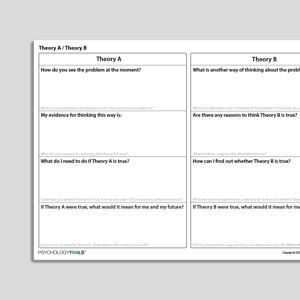Obsessive Compulsive Disorder (OCD) Formulation
The cognitive approach to obsessive compulsive disorder (OCD) suggesst that it is the client’s interpretation of normal intrusive thoughts, images, and urges as threatening or significant which drives their distress and maladaptive responses. The Obsessive Compulsive Disorder (OCD) Formulation worksheet is a case conceptualization tool for cognitive behavioral therapists.
Download or send
Related resources
Tags
Languages this resource is available in
Problems this resource might be used to address
Techniques associated with this resource
Mechanisms associated with this resource
Introduction & Theoretical Background
Cognitive behavioral models of obsessive compulsive disorder (OCD) suggest that it is the client’s interpretation of normal intrusive thoughts, images, and urges as threatening or significant which drives their distress and maladaptive responses (Shafran, 2005; Taylor et al, 2007). Intrusive thoughts, images, urges, and doubts are very common and entirely normal (Purdon and Clark, 1993, 1994): the cognitive analysis of OCD proposes that what gives intrusions their emotional power in OCD is the meaning that clients assign to them (Salkovskis, 1985). Individuals with OCD commonly interpret the occurrence or content of their intrusions as:
- Meaning something is wrong with them
- Signaling that something bad will happen.
- Meaning that they are personally responsible for preventing harm to themselves or others.
Interpreting intrusions through the lens of responsibility has a number of effects including: increased discomfort, increased focus of attention on the intrusions, increased accessibility of the intrusions, active attempts
Therapist Guidance
This worksheet is designed as a case conceptualization tool for therapists. If it is used with clients it can help to structure a discussion about how the client’s experiences and reactions interact. Case conceptualization is considered to be most effective when it is collaborative exploration of a client’s difficulties rather than presented as a ‘completed solution’ (Kuyken, Padesky, Dudley, 2011). If the worksheet is used in session with a clients, it is best introduced as a tentative tool for exploration.
The therapist might introduce it by saying “Some people’s OCD responses fit the kind of pattern we see on this diagram. I wonder if we could we explore some of your thoughts, feelings, and reactions and see what kind of pattern they follow?”.
- Ask the client to think of a recent time when they experienced an intrusion
- Help the client to focus on the meaning of the intrusion: “What does
References And Further Reading
- Kuyken, W., Padesky, C. A., & Dudley, R. (2011). Collaborative case conceptualization: Working effectively with clients in cognitive-behavioral therapy. Guilford Press.
- Purdon, C., & Clark, D. A. (1993). Obsessive intrusive thoughts in nonclinical subjects. Part I. Content and relation with depressive, anxious and obsessional symptoms. Behaviour Research and Therapy, 31(8), 713-720.
- Purdon, C., & Clark, D. A. (1994). Obsessive intrusive thoughts in nonclinical subjects. Part II. Cognitive appraisal, emotional response and thought control strategies. Behaviour Research and Therapy, 32(4), 403-410.
- Salkovskis, P.M. (1985). Obsessional-compulsive problems: A cognitive-behavioural analysis. Behaviour Research and Therapy, 23, 571-583.
- Salkovskis, P. M., Forrester, E., & Richards, C. (1998). Cognitive–behavioural approach to understanding obsessional thinking. The British Journal of Psychiatry, 173(S35), 53-63.
- Shafran, R. (2005). Cognitive-behavioral models of OCD. In Concepts and controversies in obsessive-compulsive disorder (pp. 229-260). Boston: Springer US.
- Taylor, S., Abramowitz, J. S., & McKay, D. (2007). Cognitive-Behavioral Models of Obsessive-Compulsive Disorder.



